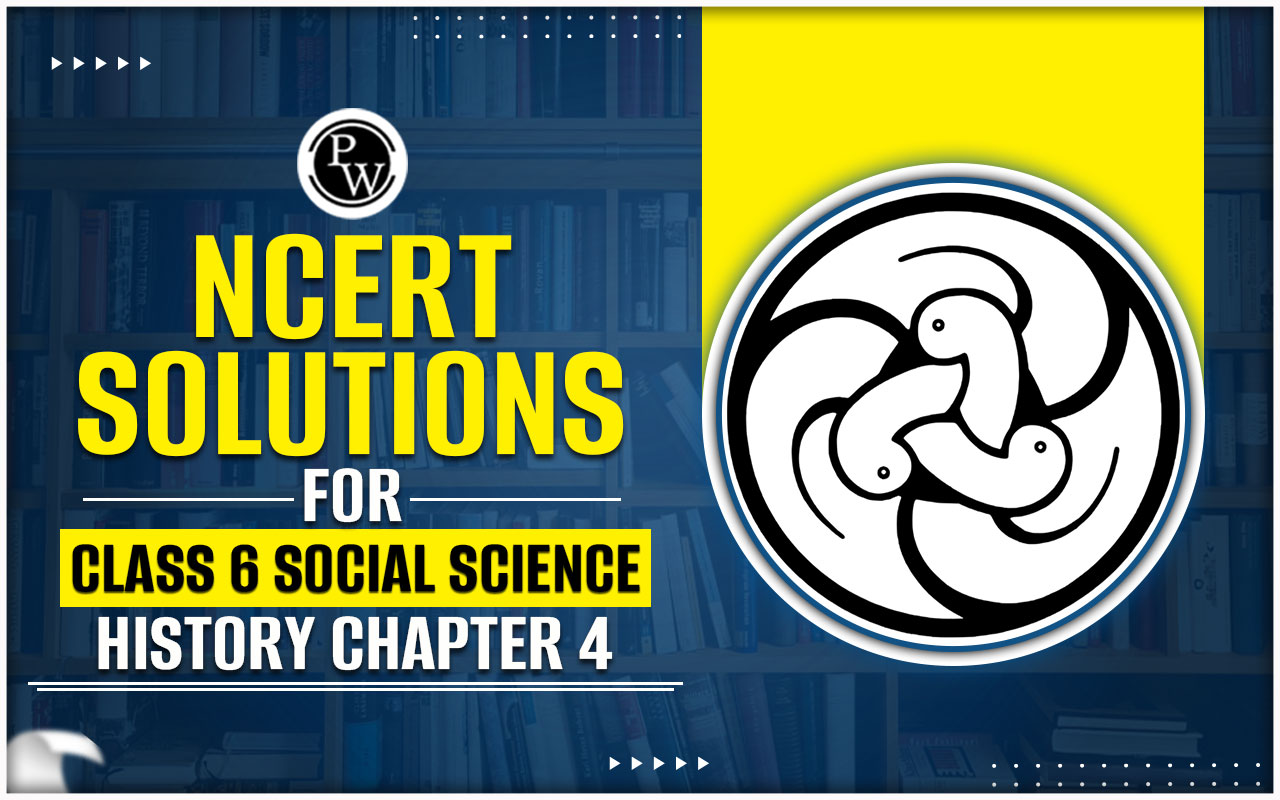

NCERT Solutions for Class 6 Social Science History Chapter 4
NCERT Solutions for Class 6 Social Science History Chapter 4 : As students, delving into history can feel like a chore at times. Dates, names, and facts swirl together into an overwhelming blur. However, history is so much more than lists and timelines - it is a journey into the lives and cultures of people from eras past. In this post, we will delve into what books and burial sites from ancient India can teach us about the development of early Indian civilization as outlined in Chapter 4 - "What Books and Burials Tell Us" from the NCERT Social Science textbook for Class 6. Through a close examination of original source materials unearthed by archaeologists, we aim to bring alive for the student the rich tapestry of beliefs, social hierarchies, and cultural practices of societies that thrived thousands of years ago on the Indian subcontinent.NCERT Solutions for Class 6 Social Science History
NCERT Solutions for Class 6 Social Science History Chapter 4 Overview
The chapter explores the Vedas, Megaliths, and Inamgaon, shedding light on ancient civilizations and their cultural elements. For effective preparation for NCERT Class 6 History Chapter 4 exams, Physics Wallah offers abundant resources tailored to align with the NCERT pattern. Our comprehensive materials are meticulously crafted by subject experts, ensuring they not only enhance your exam readiness but also deepen your understanding of the subject. Access the free PDF download of NCERT Solutions for Class 6 Social Science Chapter 4, "What Books and Burials Tell Us," on PW, providing valuable assistance for your exam preparations.NCERT Solutions for Class 6 Social Science History Chapter 2
NCERT Solutions for Class 6 Social Science History Chapter 4 What Books and Burials Tell Us
Key topics covered in NCERT Solutions for Class 6 Social Science History Chapter 4 provide students with a comprehensive understanding of the archaeological and historical aspects of ancient civilizations. The chapter encourages critical thinking and analysis of artifacts to reconstruct the past.1) Megaliths and Their Significance:
- Understanding the meaning and purpose of megaliths in ancient civilizations.
- Examining the distribution of megaliths in different regions like South India, Kashmir, and the North East.
2) Burial Practices and Artifacts:
- Exploring the use of stone circles or boulders to mark burial sites.
- Analyzing the presence of artifacts, especially pots, in burials to discern social differences.
3) Social Hierarchies in Ancient Societies:
- Investigating evidence from burials to determine social distinctions among individuals.
- Discussing the lifestyle differences between individuals of higher social status (Raja) and those with lower status (Dasa or Dasi).
4) Inamgaon: Insights into Ancient Life:
- Studying the archaeological findings from Inamgaon to gain insights into the daily life, diet, and practices of ancient people.
- Examining the food habits, including the consumption of peas, pulses, rice, barley, and sesame.
5) Archaeological Methods and Discoveries:
- Understanding the role of archaeologists in uncovering historical information.
- Reflecting on the significance of burial sites and the artifacts found in understanding ancient civilizations.
NCERT Solutions for Class 6 Social Science History Chapter 7
6) Cultural Practices and Rituals:
- Exploring the role of rituals like Sukta and Yajna in ancient societies.
- Investigating the use of chariots in battles as part of cultural practices.
7) Historical Geography:
- Recognizing the geographical distribution of megaliths and archaeological sites in different parts of India.
8) Comparative Analysis:
- Comparing the lifestyles, roles, and societal structures of different groups in ancient times.
NCERT Solutions for Class 6 Social Science History Chapter 1
NCERT Solutions for Class 6 Social Science History Chapter 4 Important Questions
Here are the important questions for NCERT Solutions for Class 6 Social Science History Chapter 4 What Books and Burials Tell Us: 1. Why is the decipherment of the Harappan script challenging for historians? The decipherment of the Harappan script is challenging for historians because there is a limited number of inscriptions available, and the script lacks a bilingual text that could aid in understanding its meaning. The Harappan script remains undeciphered, posing a significant challenge in interpreting the language of the Indus Valley Civilization. 2. How did Emperor Ashoka use inscriptions to communicate with his subjects? Emperor Ashoka used inscriptions to communicate with his subjects by engraving his messages on pillars and rocks. These Ashokan inscriptions were written in the Brahmi script. Ashoka's messages conveyed moral teachings, instructions for righteous living, and his commitment to non-violence and Dhamma. 3. Explain the significance of seals in ancient times. Seals were significant in ancient times for various purposes. They were used for marking ownership, ensuring the authenticity of goods, and serving as personal symbols. Seals were impressed on clay or other materials to create an impression, and they played a crucial role in trade, administration, and as identifying marks for individuals. 4. How do burial sites provide insights into ancient societies? Burial sites provide insights into ancient societies by revealing information about burial practices, religious beliefs, social hierarchies, and cultural aspects. The study of burial sites helps historians understand how people treated their deceased, the rituals associated with death, and the societal distinctions based on burial practices. 5. Why do historians face challenges in interpreting pre-literate societies? Historians face challenges in interpreting pre-literate societies because these societies did not have a writing system to record their history. Communication in pre-literate societies relied on oral traditions, symbols, and gestures. Deciphering symbols without a written context poses difficulties for historians in understanding the complexities of ancient languages and cultures.NCERT Solutions for Class 6 Social Science History Chapter 3
6. Discuss the role of historians in reconstructing the past. Historians play a crucial role in reconstructing the past by analyzing various sources such as books, scripts, artifacts, and burial sites. They use interdisciplinary approaches, combining linguistic analysis, archaeology, and interpretation skills to piece together a comprehensive narrative of ancient civilizations. Historians contribute to unraveling the mysteries of the past and providing insights into the cultural, social, and economic aspects of historical societies. 7. How did the discovery of the Rosetta Stone contribute to deciphering ancient scripts? The discovery of the Rosetta Stone was instrumental in deciphering ancient scripts, particularly Egyptian hieroglyphs. The Rosetta Stone, discovered in 1799, contained an inscription in three scripts: Greek, Demotic, and hieroglyphic. Since scholars already knew how to read Greek, they used the Greek text as a key to decipher the other scripts. This breakthrough facilitated the understanding of ancient Egyptian writings and significantly contributed to unlocking the mysteries of their civilization.NCERT Solutions for Class 6 Social Science History Chapter 8
8. Explain the significance of pottery in reconstructing the history of ancient cultures. Pottery holds significant importance in reconstructing the history of ancient cultures. The study of pottery provides insights into the technological advancements, artistic preferences, trade connections, and daily life practices of ancient societies. Pottery fragments found at archaeological sites help historians determine the time period, cultural influences, and economic activities of a particular civilization. 9. How do archaeologists use stratigraphy to interpret the chronological sequence of a site? Archaeologists use stratigraphy to interpret the chronological sequence of a site by studying the layers of sediment or soil. Stratigraphy involves analyzing the different layers (strata) in an archaeological site. The principle of superposition states that lower layers are older than upper layers. By examining the artifacts and remains in each layer, archaeologists can establish a timeline of human activities, helping reconstruct the historical development of the site. 10. Discuss the role of trade in influencing the cultural exchange between ancient societies. Trade played a pivotal role in influencing cultural exchange between ancient societies. Through trade routes, societies engaged in the exchange of goods, ideas, technologies, and cultural practices. The Silk Road, for example, facilitated the movement of goods and cultural elements between Asia, the Middle East, and Europe. Trade not only contributed to economic prosperity but also fostered cross-cultural interactions, leading to the enrichment and diversification of societies. 11. Why is the study of ancient scripts essential for understanding the cultural heritage of a region? The study of ancient scripts is essential for understanding the cultural heritage of a region because scripts serve as a unique expression of a society's language, beliefs, and historical narratives. Deciphering ancient scripts allows historians to access written records, literary works, and inscriptions that provide insights into the cultural practices, religious beliefs, and societal norms of the past. Understanding ancient scripts is crucial for preserving and appreciating the rich cultural heritage of a region. 12. How does the preservation of artifacts contribute to our knowledge of ancient civilizations? Answer: The preservation of artifacts contributes significantly to our knowledge of ancient civilizations. Artifacts, such as pottery, tools, sculptures, and everyday objects, provide tangible evidence of the material culture, technological advancements, and artistic expressions of ancient societies. The careful preservation of these artifacts allows historians and archaeologists to study and analyze the material remains, leading to a deeper understanding of the social, economic, and cultural aspects of past civilizations. These answers provide a comprehensive understanding of the key concepts covered in Chapter 4 of Class 6 Social Science History.NCERT Solutions for Class 6 Social Science History Chapter 5
NCERT Solutions for Class 6 Social Science History Chapter 4 Exercises
In the intriguing journey through time and history, Chapter 4 of Class 6 Social Science History takes young learners into the fascinating realm of "What Books and Burials Tell Us." As students explore this chapter, they encounter the rich tapestry of ancient civilizations and the methods archaeologists employ to unravel their secrets. To enhance their understanding, the chapter offers a set of exercises with insightful questions, and here we delve into the solutions: 1. What is archaeology, and how does it contribute to understanding history? Archaeology is the study of human history and prehistory through the excavation of artifacts, structures, and other physical remains. It contributes to understanding history by providing tangible evidence of past civilizations, their lifestyles, technological advancements, and cultural practices. Through the analysis of artifacts and excavated sites, archaeologists reconstruct the chronology and development of human societies. 2. Explain the significance of written records in studying ancient civilizations. Written records are significant in studying ancient civilizations as they provide direct insights into the thoughts, beliefs, and historical events of a society. Documents, inscriptions, and manuscripts serve as valuable sources for understanding the political, religious, and social aspects of ancient cultures. Written records often offer a more detailed and nuanced perspective compared to archaeological findings. 3. Discuss the importance of burial sites in uncovering information about ancient societies. Burial sites are important for uncovering information about ancient societies as they offer clues about burial practices, religious beliefs, and social structures. Analysis of grave goods, tomb structures, and burial rituals provides insights into the cultural and religious aspects of a civilization. Burial sites also help archaeologists understand the social hierarchy, status, and daily life of individuals in the past. 4. How does the study of artifacts contribute to our understanding of the past? The study of artifacts contributes to our understanding of the past by providing tangible evidence of material culture. Artifacts such as tools, pottery, and personal items offer insights into the technology, craftsmanship, and daily life of ancient societies. Through artifact analysis, historians and archaeologists reconstruct economic activities, trade networks, and the overall lifestyle of past civilizations. 5. Describe the role of oral traditions in preserving historical knowledge. Oral traditions play a crucial role in preserving historical knowledge by passing down stories, legends, and cultural practices from generation to generation through spoken words. While not written, oral traditions serve as a valuable source for understanding the collective memory, traditions, and historical events of a community. They contribute to the transmission of cultural heritage and maintain a connection to the past.NCERT Solutions for Class 6 Social Science History Chapter 9
Exercise Questions - Page No. 44 6. Matching Columns:- Sukta: Well-said
- Chariots: Used in battles
- Yajna: Sacrifice
- Dasa: Slave
- Megalith: Stone Boulder
Explanation: Matching the elements, students connect the dots between terms like Sukta and well-said, unveiling the significance of each term in the context of ancient practices.
7. Complete the Sentences:- Slaves were used for work.
- Megaliths are found in South India, Kashmir, North East.
- Stone circles or boulders on the surface were used to point out the exact place of burial.
- Port holes were used for burying other members of the same family at the same place.
- People at Inamgaon ate peas, pulses, rice, barley, and sesame.
Insight: Completing these sentences, students connect historical context with daily life, understanding the practical aspects of ancient civilizations.
8. Social Differences in Burials:- Archaeologists use various evidence from burials to decipher social differences. Notably, the number of pots buried with skeletons often indicated the social status of the individual – a fascinating insight into the societal hierarchy of the time.
- The contrast between the life of a Raja, with the highest social standing, and that of a Dasa or Dasi, with the lowest social status, becomes apparent. Dasas and Dasis were treated as slaves, often captured from wars, highlighting the stark social divisions of ancient civilizations.
NCERT Solutions for Class 6 Social Science History Chapter 6
NCERT Solutions for Class 6 Social Science History Chapter 4 PDF
NCERT Solutions for Class 6 Social Science History Chapter 4 PDF offer a comprehensive and detailed understanding of ancient civilizations and their contributions to our world. From the Indus Valley civilization to the Mesopotamian cities, these solutions provide students with a deeper insight into the lives and cultures of our ancestors. By using simple language and engaging visuals, these solutions make learning history an enjoyable experience for young minds. However, it is important for students to supplement their studies with other resources as well. That is why we highly recommend checking out Physics Wallah notes and solutions, as they have proven to be extremely helpful in understanding complex concepts in science and mathematics. A combination of NCERT Solutions and Physics Wallah notes will surely result in academic success for any student. So let's continue to explore our past through these amazing resources and pave the way for a brighter future!NCERT Solutions for Class 6 Social Science History Chapter 10
What Books and Burials Tell Us Summary
The fourth chapter of Class 6 Social Science History, titled "What Books and Burials Tell Us," delves into the methods historians use to uncover the mysteries of ancient civilizations. The chapter explores the significance of books, ancient scripts, and burial sites in reconstructing the past. The chapter begins by emphasizing the importance of books in understanding history. Books serve as valuable records of events, ideas, and cultures. They help preserve knowledge and transmit it across generations. Before the invention of writing, people communicated through oral traditions, symbols, and gestures. The chapter discusses the challenges historians face in studying pre-literate societies and the methods they employ to interpret symbols. The chapter introduces the Harappan script, an ancient script used in the Indus Valley Civilization. It highlights the challenges historians encounter in deciphering this script due to the limited number of inscriptions and the absence of a bilingual script. The Ashokan inscriptions, written in the Brahmi script, are explored as another example of ancient writing. The chapter discusses the role of Emperor Ashoka in inscribing his messages on pillars and rocks. Seals played a crucial role in ancient times, serving various purposes such as marking ownership and authenticity. The chapter explains how seals were used in trade, administration, and as personal symbols. Burial sites provide valuable insights into the social, economic, and cultural aspects of ancient societies. The chapter discusses the information gleaned from burial sites, including burial practices, beliefs, and societal hierarchies. Historians face challenges in interpreting the past, especially when dealing with ancient scripts like the Harappan script. The lack of a bilingual script and the complexity of deciphering symbols present obstacles in understanding ancient languages. The chapter emphasizes the crucial role historians play in interpreting the past. By analyzing books, scripts, artifacts, and burial sites, historians piece together a comprehensive narrative of ancient civilizations.NCERT Solutions for Class 6 Social Science History Chapter 11
NCERT Solutions for Class 6 Social Science History Chapter 4 FAQs
What is the significance of Chapter 4 in Class 6 Social Science History?
How do books help us understand history according to this chapter?
What is the significance of burial sites in historical studies?
How did people in ancient times communicate before the invention of writing?
What are some examples of ancient scripts discussed in this chapter?












